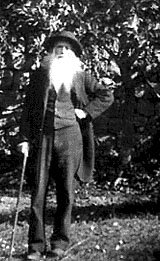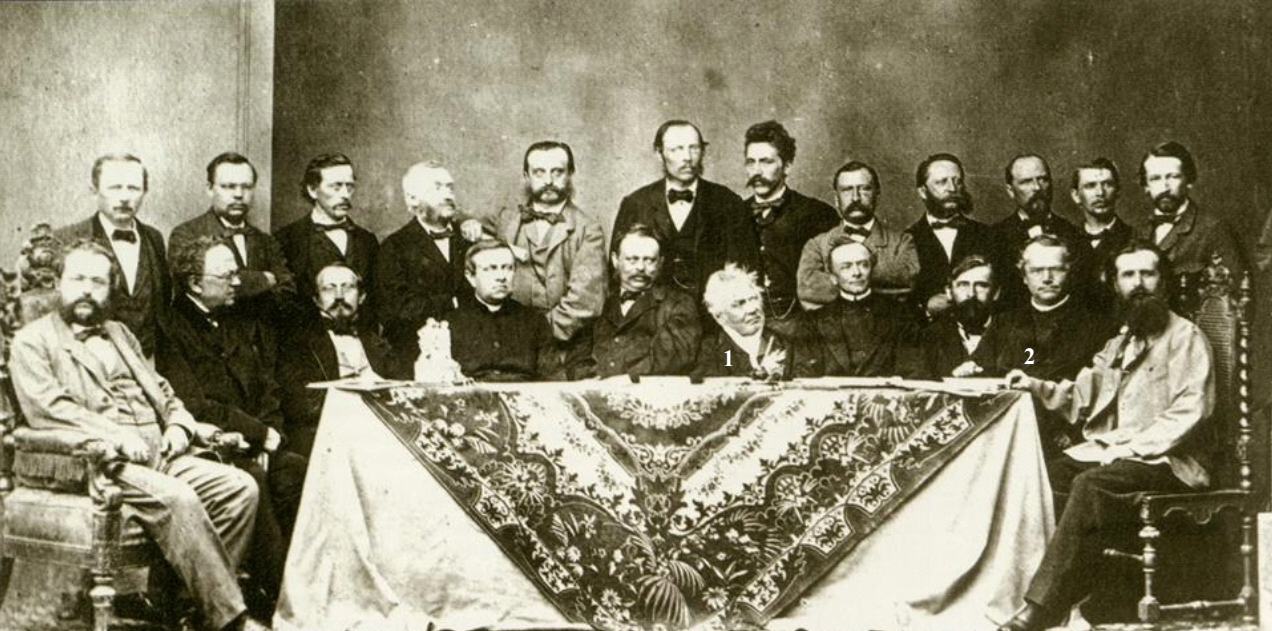|
Charles Victor Naudin
Charles Victor Naudin (14 August 1815 in Autun – 19 March 1899 in Antibes) was a French naturalist and botanist. Biography Naudin studied at Bailleul-sur-Thérain in 1825, at Limoux, and at the University of Montpellier from which he graduated in 1837. The following year he was working as a private tutor; he obtained his doctorate in 1842. He taught until 1846, when he joined the herbarium of the National Museum of Natural History. He collaborated with Augustin Saint-Hilaire on the publication of the Brazilian flora and introduced the first seeds of ''Jubaea chilensis'' in France. In 1853, botanists Planch. & Jean Jules Linden, Linden published ''Naudinia'' is a monotypic genus of flowering plants from Colombia belonging to the family Rutaceae, and named in Naudin's honour. He taught at Chaptal College as professor of zoology, but a neurological disease left him deaf. He became an assistant naturalist in 1854 and married in 1860. He entered the Academy of Sciences in 1863 w ... [...More Info...] [...Related Items...] OR: [Wikipedia] [Google] [Baidu] |
Chaptal College
Jean-Antoine Chaptal, comte de Chanteloup (; 5 June 1756 – 29 July 1832) was a French chemist, physician, agronomist, industrialist, statesman, educator and philanthropist. Chaptal was involved in early industrialization in France under Napoleon and during the Bourbon Restoration. He was a founder and the first president of the Society for the Encouragement of National Industry. He was an organizer of industrial expositions held in Paris. He compiled a study surveying the condition and needs of French industry in the early 1800s. Chaptal published practical essays on the uses of chemistry. He was an industrial producer of hydrochloric, nitric and sulfuric acids, and was sought after as a technical consultant for the manufacture of gunpowder. Chaptal published works which drew on Antoine Lavoisier's theoretical chemistry to make advances in wine-making.Chaptal, Jean-Antoine. 1801. ''L'Art de faire, de gouverner et de perfectionner les vins''Chaptal, Jean-Antoine. 1806. ''La Chim ... [...More Info...] [...Related Items...] OR: [Wikipedia] [Google] [Baidu] |
Genetics
Genetics is the study of genes, genetic variation, and heredity in organisms.Hartl D, Jones E (2005) It is an important branch in biology because heredity is vital to organisms' evolution. Gregor Mendel, a Moravian Augustinians, Augustinian friar working in the 19th century in Brno, was the first to study genetics scientifically. Mendel studied "trait inheritance", patterns in the way traits are handed down from parents to offspring over time. He observed that organisms (pea plants) inherit traits by way of discrete "units of inheritance". This term, still used today, is a somewhat ambiguous definition of what is referred to as a gene. Phenotypic trait, Trait inheritance and Molecular genetics, molecular inheritance mechanisms of genes are still primary principles of genetics in the 21st century, but modern genetics has expanded to study the function and behavior of genes. Gene structure and function, variation, and distribution are studied within the context of the Cell (bi ... [...More Info...] [...Related Items...] OR: [Wikipedia] [Google] [Baidu] |
Gregor Mendel
Gregor Johann Mendel Order of Saint Augustine, OSA (; ; ; 20 July 1822 – 6 January 1884) was an Austrian Empire, Austrian biologist, meteorologist, mathematician, Augustinians, Augustinian friar and abbot of St Thomas's Abbey, Brno, St. Thomas' Abbey in Brno (Brünn), Margraviate of Moravia. Mendel was born in a Sudeten Germans, German-speaking family in the Austrian Silesia, Silesian part of the Austrian Empire (today's Czech Republic) and gained posthumous recognition as the founder of the modern science of genetics. Though farmers had known for millennia that crossbreeding of animals and plants could favor certain desirable trait (biological), traits, Mendel's pea plant experiments conducted between 1856 and 1863 established many of the rules of biological inheritance, heredity, now referred to as the laws of Mendelian inheritance. Mendel worked with seven characteristics of Pea, pea plants: plant height, pod shape and color, seed shape and color, and flower position and c ... [...More Info...] [...Related Items...] OR: [Wikipedia] [Google] [Baidu] |
Charles Darwin
Charles Robert Darwin ( ; 12 February 1809 – 19 April 1882) was an English Natural history#Before 1900, naturalist, geologist, and biologist, widely known for his contributions to evolutionary biology. His proposition that all species of life have descended from a Common descent, common ancestor is now generally accepted and considered a fundamental scientific concept. In a joint presentation with Alfred Russel Wallace, he introduced his scientific theory that this Phylogenetics, branching pattern of evolution resulted from a process he called natural selection, in which the struggle for existence has a similar effect to the artificial selection involved in selective breeding.. Darwin has been described as one of the most influential figures in human history and was honoured by Burials and memorials in Westminster Abbey, burial in Westminster Abbey. Darwin's early interest in nature led him to neglect his medical education at the University of Edinburgh Medical Schoo ... [...More Info...] [...Related Items...] OR: [Wikipedia] [Google] [Baidu] |
Brazil
Brazil, officially the Federative Republic of Brazil, is the largest country in South America. It is the world's List of countries and dependencies by area, fifth-largest country by area and the List of countries and dependencies by population, seventh-largest by population, with over 212 million people. The country is a federation composed of 26 Federative units of Brazil, states and a Federal District (Brazil), Federal District, which hosts the capital, Brasília. List of cities in Brazil by population, Its most populous city is São Paulo, followed by Rio de Janeiro. Brazil has the most Portuguese-speaking countries, Portuguese speakers in the world and is the only country in the Americas where Portuguese language, Portuguese is an Portuguese-speaking world, official language. Bounded by the Atlantic Ocean on the east, Brazil has a Coastline of Brazil, coastline of . Covering roughly half of South America's land area, it Borders of Brazil, borders all other countries and ter ... [...More Info...] [...Related Items...] OR: [Wikipedia] [Google] [Baidu] |
Flora
Flora (: floras or florae) is all the plant life present in a particular region or time, generally the naturally occurring (indigenous (ecology), indigenous) native plant, native plants. The corresponding term for animals is ''fauna'', and for fungi, it is ''funga''. Sometimes bacteria and fungi are also referred to as flora as in the terms ''gut flora'' or ''skin flora'' for purposes of specificity. Etymology The word "flora" comes from the Latin name of Flora (mythology), Flora, the goddess of plants, flowers, and fertility in Roman mythology. The technical term "flora" is then derived from a metonymy of this goddess at the end of the sixteenth century. It was first used in poetry to denote the natural vegetation of an area, but soon also assumed the meaning of a work cataloguing such vegetation. Moreover, "Flora" was used to refer to the flowers of an artificial garden in the seventeenth century. The distinction between vegetation (the general appearance of a community) and ... [...More Info...] [...Related Items...] OR: [Wikipedia] [Google] [Baidu] |
Heredity
Heredity, also called inheritance or biological inheritance, is the passing on of traits from parents to their offspring; either through asexual reproduction or sexual reproduction, the offspring cells or organisms acquire the genetic information of their parents. Through heredity, variations between individuals can accumulate and cause species to evolve by natural selection. The study of heredity in biology is genetics. Overview In humans, eye color is an example of an inherited characteristic: an individual might inherit the "brown-eye trait" from one of the parents. Inherited traits are controlled by genes and the complete set of genes within an organism's genome is called its genotype. The complete set of observable traits of the structure and behavior of an organism is called its phenotype. These traits arise from the interaction of the organism's genotype with the environment. As a result, many aspects of an organism's phenotype are not inherited. For example, ... [...More Info...] [...Related Items...] OR: [Wikipedia] [Google] [Baidu] |
Species
A species () is often defined as the largest group of organisms in which any two individuals of the appropriate sexes or mating types can produce fertile offspring, typically by sexual reproduction. It is the basic unit of Taxonomy (biology), classification and a taxonomic rank of an organism, as well as a unit of biodiversity. Other ways of defining species include their karyotype, DNA sequence, morphology (biology), morphology, behaviour, or ecological niche. In addition, palaeontologists use the concept of the chronospecies since fossil reproduction cannot be examined. The most recent rigorous estimate for the total number of species of eukaryotes is between 8 and 8.7 million. About 14% of these had been described by 2011. All species (except viruses) are given a binomial nomenclature, two-part name, a "binomen". The first part of a binomen is the name of a genus to which the species belongs. The second part is called the specific name (zoology), specific name or the specific ... [...More Info...] [...Related Items...] OR: [Wikipedia] [Google] [Baidu] |
Acclimation
Acclimatization or acclimatisation ( also called acclimation or acclimatation) is the process in which an individual organism adjusts to a change in its environment (such as a change in altitude, temperature, humidity, photoperiod, or pH), allowing it to maintain fitness across a range of environmental conditions. Acclimatization occurs in a short period of time (hours to weeks), and within the organism's lifetime (compared to adaptation, which is evolution, taking place over many generations). This may be a discrete occurrence (for example, when mountaineers acclimate to high altitude over hours or days) or may instead represent part of a periodic cycle, such as a mammal shedding heavy winter fur in favor of a lighter summer coat. Organisms can adjust their morphological, behavioral, physical, and/or biochemical traits in response to changes in their environment. While the capacity to acclimate to novel environments has been well documented in thousands of species, research ... [...More Info...] [...Related Items...] OR: [Wikipedia] [Google] [Baidu] |
Hybrid (biology)
In biology, a hybrid is the offspring resulting from combining the qualities of two organisms of different varieties, subspecies, species or genera through sexual reproduction. Generally, it means that each cell has genetic material from two different organisms, whereas an individual where some cells are derived from a different organism is called a chimera. Hybrids are not always intermediates between their parents such as in blending inheritance (a now discredited theory in modern genetics by particulate inheritance), but can show hybrid vigor, sometimes growing larger or taller than either parent. The concept of a hybrid is interpreted differently in animal and plant breeding, where there is interest in the individual parentage. In genetics, attention is focused on the numbers of chromosomes. In taxonomy, a key question is how closely related the parent species are. Species are reproductively isolated by strong barriers to hybridization, which include genetic and morph ... [...More Info...] [...Related Items...] OR: [Wikipedia] [Google] [Baidu] |
Jacques Nicolas Ernest Germain De Saint-Pierre
Jacques Nicolas Ernest Germain de Saint-Pierre (1 December 1814, Saint-Pierre-le-Moûtier – 28 June 1882, Hyères) was a French botanist.Prosopo Sociétés savantes de France The plant genera '' Diserneston'' of the family and '' Ernestella'' and '' Saintpierrea'' of the family were named in his honor.Burkhardt, Lotte (2022). Eine Enzyklopädie zu ... [...More Info...] [...Related Items...] OR: [Wikipedia] [Google] [Baidu] |








